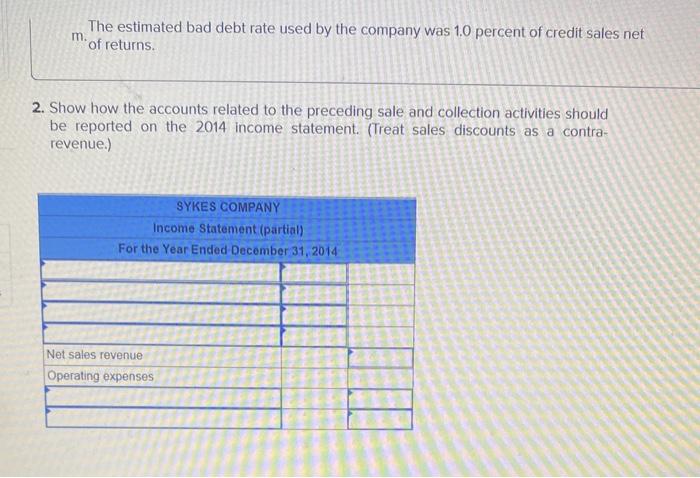Required information [The following information applies to the questions displayed below.] The following data were selected from the records of Sykes Company for the year ended December 31, 2014. In the following order, except for cash sales, the company sold merchandise and made collections on credit terms 5/10,n/30 (assume a unit sales price of $800 in all transactions and use the gross method to record sales revenue). Transactions during 2014 a. Sold merchandise for cash, $264,000. b. Sold merchandise to R. Smith; invoice price, $9,500. c. Sold merchandise to K. Miller; invoice price, $26,000. d. Two days after purchase date, R. Smith returned one of the units purchased in (b) and recelved account credit. e. Sold merchandise to B. Sears; invoice price, $29,000. f. R. Smith paid his account in full within the discount period. Collected $97,000 cash from customer sales on credit in prior year, all within the 9. discount periods. Required: 1. Using the following categories, indicate the effect of each listed transaction, including the write-off of the uncollectible account and the adjusting entry for estimated bad debts (ignore cost of goods sold). The first transaction is used as an example. (Round your answers to the nearest whole dollar amount. Amounts to be deducted should be indicated by a minus sign.) In the following order, except for cash sales, the company sold merchandise and made collections on credit terms 5/10,n/30 (assume a unit sales price of $800 in all transactions and use the gross method to record sales revenue). Transactions during 2014 a. Sold merchandise for cash, $264,000. b. Sold merchandise to R. Smith; invoice price, $9,500. c. Sold merchandise to K. Miller, invoice price, $26,000. d. Two days after purchase date. R. Smith returned one of the units purchased in (b) and received account credit. e. Sold merchandise to B. Sears; invoice price, $29,000. f. R. Smith paid his account in full within the discount period. Collected $97.000 cash from customer sales on credit in prior year, all within the g. discount periods. h. K. Miller paid the invoice in (c) within the discount period. 1. Sold merchandise to R. Roy; invoice price, $23,500. j. Three days after paying the account in full, K. Miller returned seven defective units and recelved a cash refund. a prior year. Wrote off a 2013 account of $4,000 after deciding that the amount would never be collected. The estimated bad debt rate used by the company was 1.0 percent of credit sales net The estimated bad debt rate used by the company was 1.0 percent of credit sales net m. of returns. 2. Show how the accounts related to the preceding sale and collection activities should be reported on the 2014 income statement. (Treat sales discounts as a contrarevenue.)










